Introduction
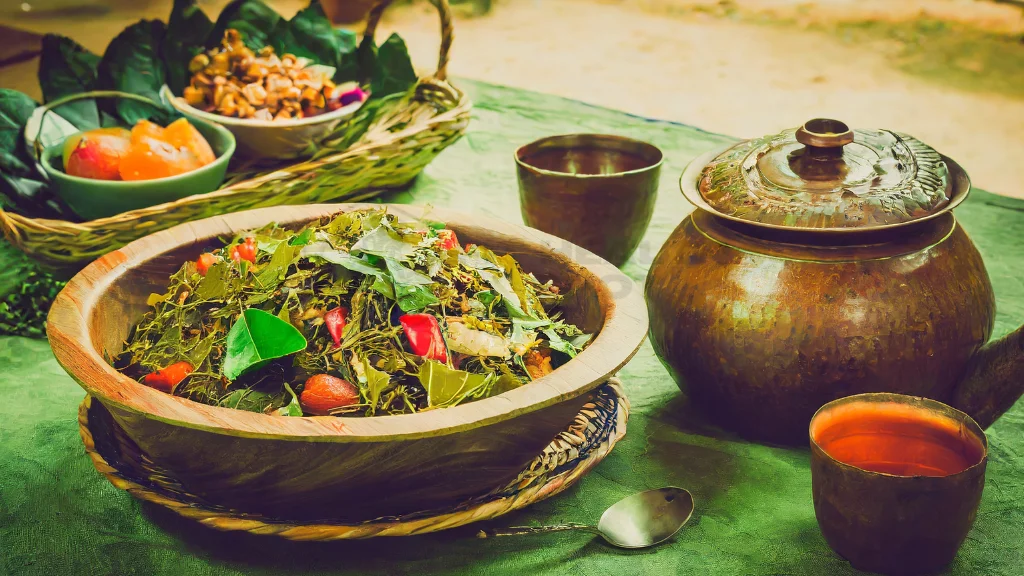
The vibrant nation of Myanmar, formerly known as Burma, is not just famous for its golden pagodas and serene landscapes but also its rich culinary traditions. One such gem from its gastronomic treasure trove is the Tea Leaf Salad, locally referred to as “Laphet Thoke.”
Dating back centuries, this dish is more than just a palate pleaser. It’s a symbol of Burmese hospitality and a testament to the country’s intricate relationship with tea. In Myanmar, offering tea leaves is not just a culinary gesture but also a social one. During significant events or family gatherings, a tray with various accompaniments, including fermented tea leaves, nuts, and other tidbits, would be presented as a mark of respect and camaraderie.
I remember my first encounter with this dish during a visit to a small eatery in Mandalay. The owner, a kind older woman, upon learning it was my first trip to Myanmar, insisted I try the Tea Leaf Salad. She mentioned that it was her grandmother’s recipe, passed down through generations. As I took the first bite, the symphony of flavors – tangy, savory, crunchy, and slightly bitter – was unlike anything I had tasted before. It wasn’t just the taste but the warmth and love with which it was served that made it unforgettable.
Today, while the dish has found its way to restaurants worldwide, the essence of Laphet Thoke remains rooted in Burmese traditions, making it not just a salad but a slice of Myanmar’s rich cultural tapestry.
Ingredients
Embarking on the journey to make a traditional Tea Leaf Salad requires a harmonious blend of ingredients. While the dish’s essence remains consistent, variations exist depending on the region and personal preferences. Here’s a detailed breakdown:
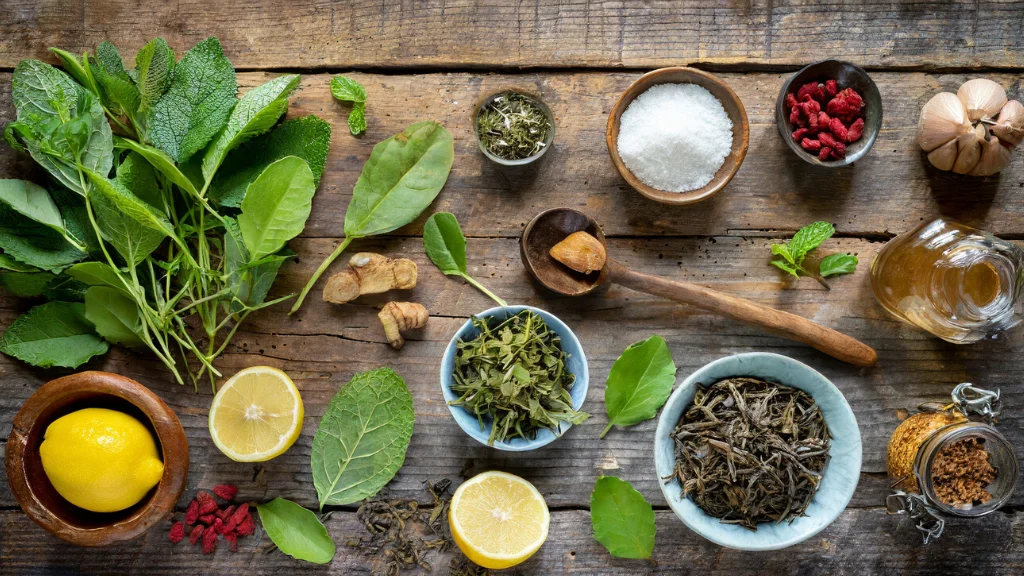
Primary Ingredients:
- Fermented tea leaves: 1 cup
- Fried Garlic: 2 tablespoons
- Toasted sesame seeds: 1 tablespoon
- Roasted peanuts: 1/2 cup
- Diced tomatoes: 2 medium-sized
- Shredded cabbage: 1 cup
- Dried shrimp (optional): 1 tablespoon
- Chopped green chilies: 1-2 (adjust based on your heat preference)
Variations:
- Some regions in Myanmar add sliced shallots to the mix, offering an additional layer of flavor. If you’re curious about the unique taste and benefits of shallots, you might find our comprehensive guide on shallots enlightening.
- Another popular variation is the inclusion of glass noodles, which add a delightful chewy texture to the salad. To know more about them and how they can be incorporated into various dishes, check out our complete guide on glass noodles.
Potential Substitutes:
- If you’re unable to find fermented tea leaves, pickled tea leaves can be a close alternative, though the taste might slightly differ.
- For those who prefer a vegetarian version, omit the dried shrimp and add crunchy broad beans or toasted chickpeas for that added protein and crunch.
- Fresh red chilies can replace green chilies for a different heat profile.
- In the absence of roasted peanuts, roasted cashews or almonds can be used.
Crafting the perfect Tea Leaf Salad is about balancing these ingredients, and with each variation, you get to experience a new facet of this Burmese delight. Whether you stick to the traditional recipe or venture into regional variations, the result is bound to be a flavorful and memorable dish.
Nutrition Facts
The Tea Leaf Salad isn’t just a symphony of flavors; it’s a nutritional powerhouse. Let’s delve deeper into its nutrient profile and the health benefits it brings to the table.
Nutritional Content Breakdown:

Fermented Tea Leaves: Rich in antioxidants, vitamins, and minerals. They contain catechins, which have been linked to numerous health benefits, including improved heart health and reduced risk of certain types of cancer.
Tomatoes: A good source of vitamins C, K, potassium, and folate. They’re also rich in antioxidants, including lycopene, which is beneficial for heart health.
Garlic: Known for its medicinal properties, Garlic is low in calories but very rich in Vitamin C, Vitamin B6, and Manganese. It also contains trace amounts of various other nutrients. To understand more about its numerous health benefits, our in-depth guide on garlic cloves is worth a read.
Sesame Seeds and Peanuts: High in healthy fats and an excellent source of protein, vitamins, and minerals.
Cabbage: Low in calories but high in fiber and vitamins C and K.
Health Benefits of Primary Ingredients:
Tea Leaves: Beyond just being the star ingredient in terms of flavor, tea leaves are packed with antioxidants. These help combat oxidative stress in the body and reduce the risk of chronic diseases.
Shallots: While not in the primary list, when added, shallots bring a range of benefits. They’re not only flavorful but are also known for their potential anti-cancer properties and their ability to help regulate blood sugar.
Incorporating Tea Leaf Salad in a Balanced Diet:
Tea Leaf Salad, with its blend of proteins, healthy fats, vitamins, and minerals, can be a staple in a balanced diet. When paired with a protein source like Chicken or tofu, it can make for a well-rounded meal. However, if you’re looking to add a touch of creaminess and a burst of flavor to the mix, consider introducing some Gorgonzola cheese to the salad. Not only does it elevate the taste, but Gorgonzola also brings its own set of nutritional benefits.
In conclusion, the Tea Leaf Salad is more than just a delightful dish; it’s a testament to the rich culinary heritage of Burma and a nutritional gem. Whether you’re a health enthusiast or a gourmet, this salad caters to both your palate and well-being.
Preparation and Directions
Creating the Tea Leaf Salad is a delightful culinary journey that takes you through a blend of textures and flavors. Let’s embark on this journey with a step-by-step guide, ensuring that each bite of the salad is a burst of Burmese tradition.
Step-by-Step Guide:
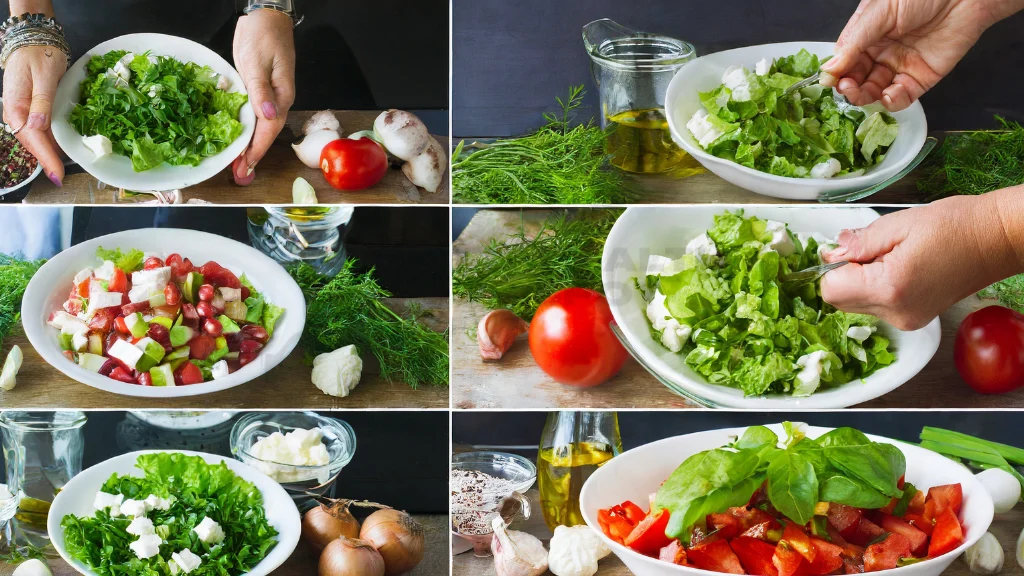
Preparation of Tea Leaves: Begin by rinsing the fermented tea leaves to remove any excess bitterness. Drain them well and set aside.
Dressing Preparation: In a small bowl, whisk together lime juice, fish sauce, and garlic oil. Adjust the flavors as per your preference. If you’re looking for a hint of sweetness, add a teaspoon of palm sugar.
Veggies & Nuts: Thinly slice the tomatoes, cabbage, and shallots. For a unique texture and flavor, consider adding lima beans to your ingredient list. Roast the sesame seeds and peanuts until they’re golden brown and crunchy.
Mixing: In a large bowl, combine the tea leaves, sliced vegetables, and nuts. Pour the dressing over and give it a good toss until everything is well-coated.
Garnish: Top the salad with extra sesame seeds, peanuts, and fried Garlic for added crunch.
Tips for the Best Flavor and Texture:
- Tea Leaves: Ensure that the tea leaves are properly rinsed to strike the right balance between their natural bitterness and the tanginess of the lime.
- Dressing: The dressing can make or break the salad. Taste and adjust the flavors continually. For an extra kick, you can add a touch of chili.
- Crunch Factor: The crunch of the sesame seeds, peanuts, and fried Garlic not only adds to the texture but also enhances the overall flavor profile. Ensure they are roasted or fried to perfection.
- Freshness: Use fresh ingredients. The freshness of the tomatoes and cabbage plays a pivotal role in the overall taste of the salad.
For a deeper dive into the world of flavors and to understand the versatility of ingredients, check out this credible source on global cuisines.
By following these steps and tips, you’ll be able to recreate a traditional Tea Leaf Salad that’s not only authentic in taste but also rich in cultural significance. Enjoy this delightful Burmese treat!
Special Tips and Tricks
Navigating the nuances of Burmese cuisine, especially with a dish as intricate as the Tea Leaf Salad, can be a tad overwhelming. But with a few specialized tips, you can master this dish and make it a regular feature of your culinary repertoire.
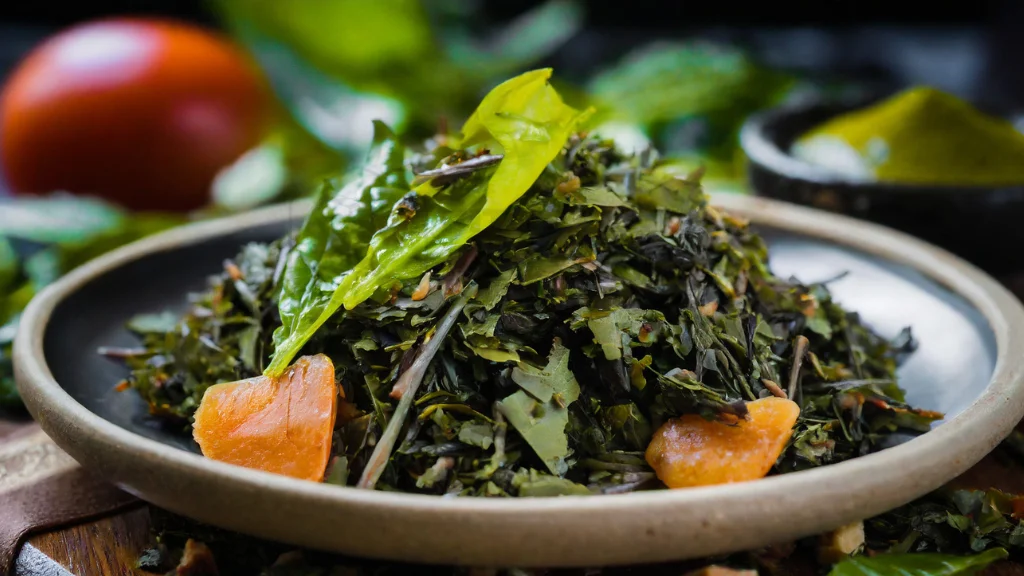
Storing Leftover Salad or Ingredients:
- Tea Leaf Salad: If you have leftover salad, place it in an airtight container and refrigerate. Consume within a day to enjoy its freshness. If you’ve added crunchy elements like peanuts or sesame seeds, consider storing them separately to retain their crunch when you have the salad next.
- Tea Leaves: Fermented tea leaves can be refrigerated in a sealed container for up to a week. For extended storage, consider freezing them. Before use, thaw and rinse as usual.
- Fresh Ingredients: Vegetables like tomatoes and cabbage should be stored in the vegetable compartment of your fridge. For a fresh twist, you might want to explore the addition of green papaya to your salad.
Best Pairings with the Salad:
- Drinks: The tangy and slightly bitter profile of the Tea Leaf Salad pairs wonderfully with a cold glass of lemon iced tea or a light white wine.
- Main Courses: If you’re serving the salad as an appetizer, consider pairing it with grilled Chicken or fish. For vegetarians, a spicy tofu stir-fry can complement the flavors beautifully.
- Sides: The salad goes well with sides that have milder flavors, allowing the unique taste of the tea leaves to shine. Consider pairing it with dishes that incorporate green olives for an additional burst of flavor.
Common Mistakes and How to Avoid Them:
- Oversoaking the Tea Leaves: While rinsing the tea leaves is essential to remove bitterness, over-soaking can lead to a loss of flavor. Limit the rinse to a maximum of two times.
- Over-dressing: Less is more when it comes to the dressing. Start with a small amount and add as needed. Remember, you can always add more, but you can’t take it away.
- Not Tasting As You Go: This is perhaps the most common mistake. Continuously taste and adjust the flavors, ensuring a balanced profile that suits your palate.
With these tips at your disposal, not only will you create a delightful Tea Leaf Salad, but you’ll also elevate the entire dining experience for your guests and yourself. Happy cooking!
Variations and Regional Differences
The Tea Leaf Salad, known as “Lahpet Thoke” in Burmese, is more than just a dish; it’s a representation of Myanmar’s rich culinary heritage. Across the country’s diverse regions, different variations of this salad emerge, each with its unique twist, echoing local preferences and ingredients.
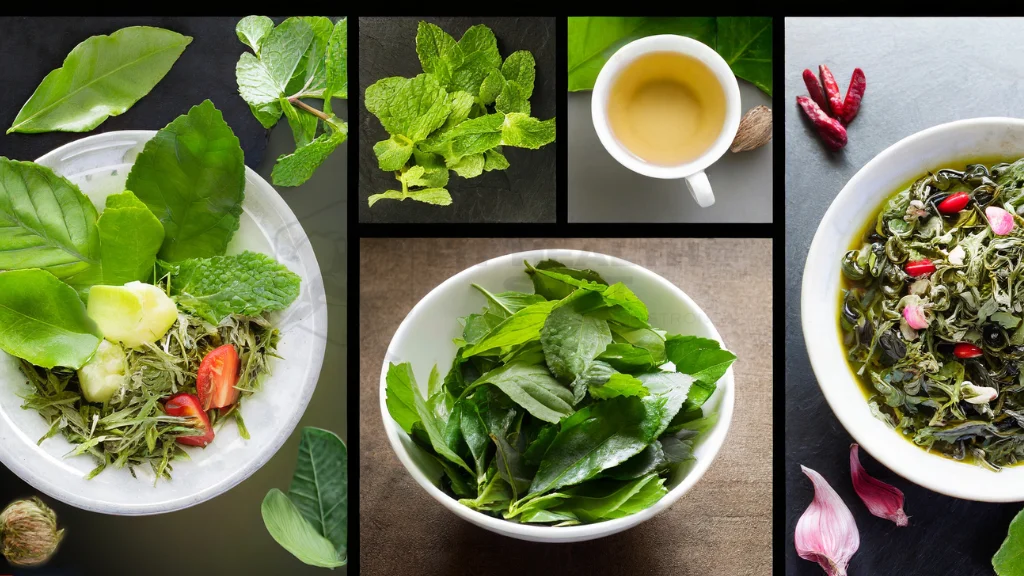
Regional Varieties:
- Shan State: Nestled in the eastern part of Myanmar, Shan State boasts a version of Tea Leaf Salad that often includes boiled potatoes. This hearty addition provides a delightful contrast to the tangy tea leaves.
- Yangon: In the bustling city of Yangon, you’ll often find a more urban adaptation. Here, the salad is commonly garnished with crispy Garlic and broad beans, adding a contemporary touch to the traditional dish.
- Mandalay: The royal city of Mandalay, known for its rich history, offers a sweeter version. The addition of jaggery (palm sugar) and sometimes even a splash of green tea shots lend a sweet undertone, balancing the bitterness of the tea leaves.
The “Burma Superstar” Version:
The “Burma Superstar” restaurant, a gem located far from Myanmar’s shores, has popularized its rendition of the Tea Leaf Salad. This version is characterized by its meticulous presentation, with each ingredient laid out separately. Diners are treated to a spectacle as the ingredients are mixed tableside, ensuring the freshest taste. The “Burma Superstar” salad is noted for its inclusion of dried shrimp, lending a subtle umami flavor, and sometimes a handful of cavatappi pasta for an added crunch and twist.
The myriad variations of the Tea Leaf Salad underscore its versatility and the deep-rooted love for this dish across regions. Whether you’re a purist or an experimentalist, there’s a version of Lahpet Thoke waiting for you to explore and enjoy.
Cultural Significance
In the vibrant tapestry of Burmese culture, the Tea Leaf Salad (Lahpet Thoke) stands out as a thread connecting generations, traditions, and ceremonies. This dish is more than just a culinary delight; it’s a testament to the rich cultural heritage of Myanmar and the shared experiences of its people.

Ceremonies and Traditions:
Tea Leaf Salad is not reserved solely for daily consumption or casual dining. Its prominence extends to important ceremonies, particularly in the Shan and Kachin states. During the Thingyan Festival, marking the Burmese New Year, Lahpet is offered as a symbol of peace and unity. This gesture of sharing tea leaves, often presented in lacquerware, is an age-old practice that signifies reconciliation and the strengthening of communal bonds.
In marriage ceremonies, the mixing of tea leaves is symbolic of the union of two families. The act of blending different ingredients mirrors the coming together of the bride and groom’s families, hoping for a harmonious life ahead.
Voices from the Heartland:
Ming, a local from Mandalay, reminisces, “During my childhood, our family gatherings always had Lahpet Thoke. My grandmother would say that sharing this dish is like sharing stories – each ingredient has its tale, and together, they form our shared history.”
Aung, a tea farmer from the Shan State, shares, “Our tea leaves are not just for brewing. They carry our traditions, our joys, and even our sorrows. Every bite of Lahpet Thoke is a journey through our land’s lush green fields and the stories of its people.”
While dishes like smoked salmon have their unique places in global cuisines, and ingredients like buckwheat flour tell tales of their regions, Lahpet Thoke holds a special place in the hearts of the Burmese. It’s a dish that encapsulates the essence of Myanmar – its history, its traditions, and its people.
Related Recipes
The rich tapestry of Burmese cuisine offers a variety of dishes that complement the Tea Leaf Salad. While the salad itself is a marvel of flavors and textures, other Burmese dishes can complete your culinary journey. Here are a couple of related recipes:
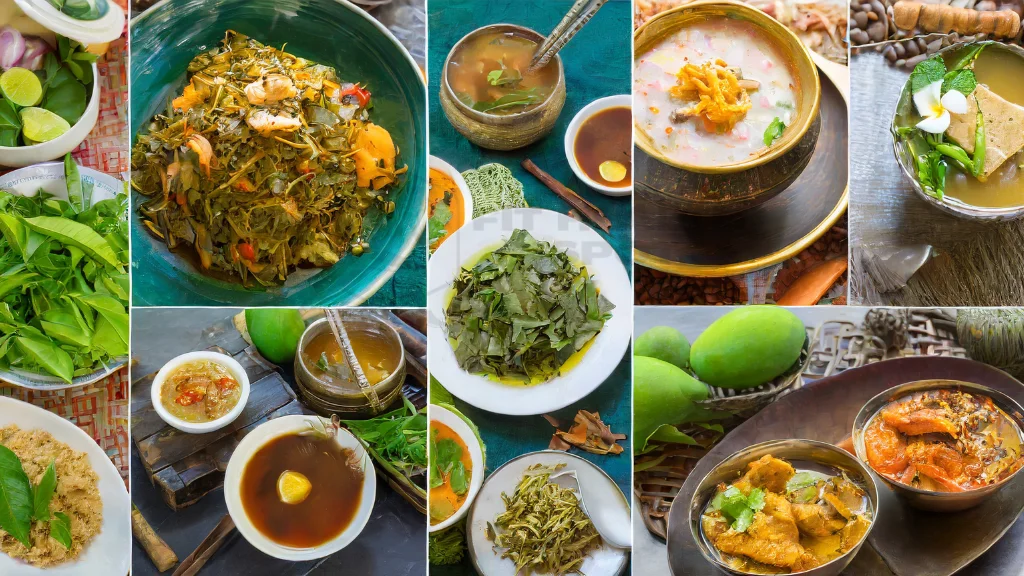
Burmese Ginger Salad (Gin Thoke)
This salad is a delightful combination of ginger, fried Garlic, toasted sesame seeds, roasted peanuts, and other crunchy beans. Here’s how to make it:
Ingredients:
- Fresh ginger strips: 1 cup
- Shredded cabbage: 1 cup
- Fried Garlic: 2 tbsp
- Toasted sesame seeds: 1 tbsp
- Roasted peanuts: 2 tbsp
- Lime juice: 1 tbsp
- Fish sauce: 1 tsp
- Peanut oil: 2 tbsp
- Salt to taste
Directions:
- Start by mixing the ginger strips and shredded cabbage in a bowl.
- Add toasted sesame seeds, roasted peanuts, and fried Garlic.
- In a separate bowl, whisk together lime juice, fish sauce, peanut oil, and Salt.
- Pour the dressing over the salad and toss well.
- Garnish with some more sesame seeds and peanuts before serving.
Shan Noodles:
A comforting bowl of noodles soaked in a flavorful broth, Shan Noodles is a must-try!
Ingredients:
- Rice noodles: 200g
- Chicken or pork (sliced): 200g
- Garlic (chopped): 2 cloves
- Soy sauce: 2 tbsp
- Chicken broth: 500ml
- Pickled mustard greens: 1/4 cup
- Crispy shallots: for garnish
- Peanut oil: 2 tbsp
- Salt to taste
Directions:
- In a pot, heat peanut oil and sauté Garlic until it’s fragrant.
- Add the sliced Chicken or pork and cook until browned.
- Add the chicken broth, soy sauce, and Salt. Let it simmer for 20 minutes.
- Cook the rice noodles as per the package instructions.
- In a bowl, place the noodles, pour the broth over them, and top with pickled mustard greens and crispy shallots.
For those looking to explore more about health and nutrition, we recommend delving into the comprehensive benefits of oat bran and understanding the intricacies of intermittent and dry fasting. These resources can guide you in making informed dietary choices.
Burmese cuisine is a blend of traditions, flavors, and stories. We hope these recipes help you savor its richness!
Conclusion
The Tea Leaf Salad, known as “Lahpet Thoke” in Burmese, is more than just a dish; it’s a symphony of flavors, textures, and traditions intricately woven into Burmese culture. Its historical significance and versatility are evident in its widespread popularity, not just in Myanmar but globally. With its unique blend of fermented tea leaves, nuts, seeds, and vegetables, it encapsulates the essence of Burmese cuisine—bold, flavorful, and rich in heritage.
As you embark on your culinary journey exploring this iconic dish, we invite you to share your experiences. Whether you’ve prepared it at home or savored it in a local Burmese eatery, every story adds a new dimension to this beloved salad. By sharing, you’re not just recounting a personal experience but also contributing to a global tapestry of culinary tales. We encourage you to spread the knowledge, celebrate the traditions, and immerse yourself in the gastronomic wonders of Myanmar.
References and Further Reading
For those keen to delve deeper into Burmese cuisine and the stories behind its iconic dishes, we recommend the following resources:
Books:
“Burma: Rivers of Flavor” by Naomi Duguid: An insightful journey into the heart of Burmese cuisine, exploring its history, traditions, and recipes.
“The Food of Myanmar: Authentic Recipes from the Land of the Golden Pagodas” by Claudia Saw Lwin Robert: A comprehensive guide to the diverse culinary landscape of Myanmar.
Articles:
“The Rich Tapestry of Burmese Cuisine” published in Gourmet Traveller: An in-depth look at the history and evolution of dishes from Myanmar.
“From Street Food to Comfort Dish: Exploring the Wonders of Burmese Eats” featured in Epicurean Digest: A chronicle of popular Burmese dishes and their significance.
Documentaries:
“The Flavorful Origins: Myanmar”: A visual treat that takes viewers on a journey through the streets of Myanmar, exploring its food culture and traditions.
Note: While every effort has been made to ensure the accuracy of the information presented in this blog, readers are advised to cross-reference with sources or expert advice before making any culinary decisions.
Frequently Asked Questions (FAQs) about Tea Leaf Salad
What is the main ingredient in Tea Leaf Salad?
The primary ingredient in Tea Leaf Salad, or “Lahpet Thoke,” is fermented tea leaves. These leaves are mixed with a variety of ingredients, such as fried Garlic, toasted sesame seeds, peanuts, dried shrimp, and tomato slices, to create the iconic dish.
Is Tea Leaf Salad consumed as a main dish or a side dish?
While Tea Leaf Salad can be enjoyed as a main dish due to its rich flavors and hearty ingredients, it is traditionally served as a side dish or appetizer in Burmese meals.
How is the taste of fermented tea leaves different from regular tea leaves?
Fermented tea leaves have a distinct flavor profile that’s tangy, slightly bitter, and aromatic. The fermentation process gives the leaves a deeper, more robust taste compared to regular, unfermented tea leaves.
Can I make Tea Leaf Salad without some of the traditional ingredients?
Yes, the beauty of Lahpet Thoke is its versatility. While there are traditional ingredients that give it its signature taste, you can adapt the recipe based on availability and personal preferences. If you’re missing an ingredient, you can omit it or substitute it with something similar.
Is Tea Leaf Salad suitable for vegetarians or vegans?
Traditional Tea Leaf Salad recipes often include ingredients like dried shrimp, making it unsuitable for vegetarians or vegans. However, you can easily modify the recipe by omitting the shrimp and using plant-based alternatives to cater to vegetarian or vegan diets.
